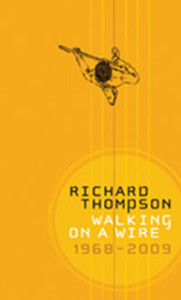 What can you say about a musician whose career began more than 40 years ago and whose creative and physical energies are still going strong? If the artist in question is Richard Thompson, you needn’t say anything. Just open the cover of the career-spanning box set Walking On A Wire: 1968-2009 and marvel.
What can you say about a musician whose career began more than 40 years ago and whose creative and physical energies are still going strong? If the artist in question is Richard Thompson, you needn’t say anything. Just open the cover of the career-spanning box set Walking On A Wire: 1968-2009 and marvel.
The timing couldn’t have been much better when this set was released in 2009. Thompson, for decades the quintessential cult artist, has been gaining more and more public honors. In 2006 he received a lifetime achievement award from the BBC, in the summer of 2010 he curated the Meltdown festival in London, and in 2011 he was appointed to the Order of the British Empire by Her Majesty Elizabeth II. The attendant publicity and ongoing critical accolades for his recordings continue to make him new fans. For those who only recently learned about Thompson, say from his 1000 Years of Popular Music CD and concerts, his soundtrack for the film Grizzly Man or his 2010 live album Dream Attic, this box set is a great way to sample from his career.
These four CDs in 71 tracks do an admirable job of summarizing Richard Thompson’s career. He’s already been the subject of two other career retrospectives, the three-disc Ryko set Watching The Dark which contained in addition to studio-album tracks a liberal sampling of previously unreleased live songs; and the hefty RT box from Free Reed, which comprised only unreleased live cuts. Walking On A Wire hews strictly to the official discography. It contains at least one track from each of the first five Fairport Convention albums, and from every official Richard and Linda and Richard solo release, plus selections from a few of his “official bootlegs.”
The hardcore fans, who can always find something to argue about when it comes to this sort of thing, may be able to quibble about the track selection. But for the most part it’s an excellent compilation, in terms of representing the scope of Thompson’s career. It has just one song from each of those five Fairport albums on which Thompson played, but they’re all among the best, and all of them still make regular appearances in his setlists. The most critically acclaimed (and best) albums such as I Want To See The Bright Lights Tonight and Shoot Out The Lights have quite a few tracks here — six for the former, five for the latter. But those that the compilers perhaps felt were among the top tier but are less well-known such as Henry The Human Fly and Industry are well-represented — each of those gets three tracks. Even the wildly obscure Sweet Talker soundtrack gets a track, the finger-snapping pop song “Put Your Trust In Me.”
Do I have my own quibbles? Yes. I might have omitted, say, “MGB-GT” from 1994’s Mirror Blue which gets a total of six tracks, and included one or two more from 1996’s two-disc set You? Me? Us? which only gets two. In my humble estimation, both “Sam Jones” and “Cold Kisses” deserve the honors more than “MGB.” Unfortunately, they didn’t ask me. The nerve.
For the most part, the sound is superb. I’m especially impressed with the remastered selections from Henry. This is the first time I’ve picked up, for example, bassist Pat Donaldson’s delicious appropriation of Paul McCartney’s riffage from The Beatles’ “Helter Skelter” in RT’s equally dire “Roll Over Vaughn Williams.” “Live in fear” indeed! The only tracks that still sound thin are those from Thompson’s first post-Linda album, Hand of Kindness, which truth to tell is my least favorite in the whole canon.
The package’s design is also excellent. The 60-page booklet covers all the bases, discography, track listing, personnel, etc., and RT biographer Patrick Humphries acquits himself admirably in the liner notes. Interesting photographs from all periods of RT’s life abound.
A warning to the newer fans: If you’ve only heard the contemporary Thompson, be prepared to hear other voices singing his compositions in the earlier part of his career, contained on the first two of these four discs, which cover the Fairport Convention and Richard and Linda years. And when he does step up to the microphone himself, be prepared for a Richard Thompson who does not sound quite the same as the now-polished singer some 40 years on. Today’s strong baritone was, until about the time of 1982’s masterpiece Shoot Out The Lights a nasal and reedy tenor of sorts, the Scots-English accent more prominent. But the one-of-a-kind guitar genius — he’s there from the beginning.
(Shout! Factory, 2009)
